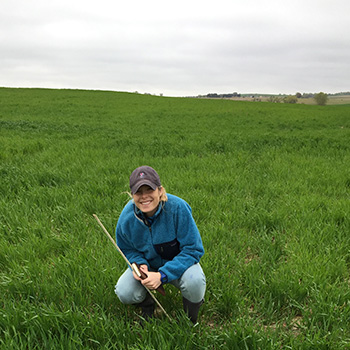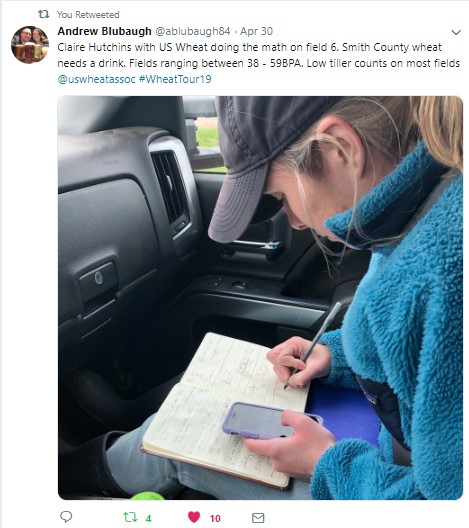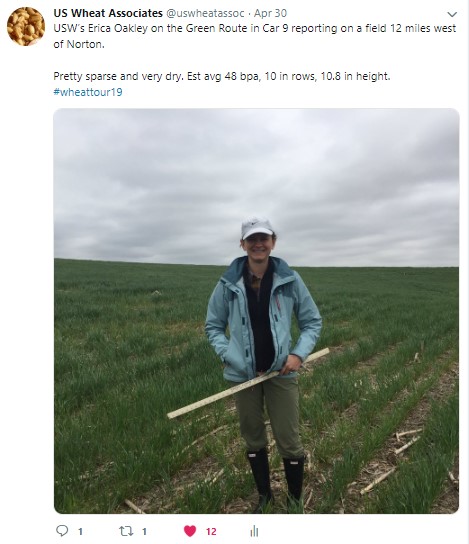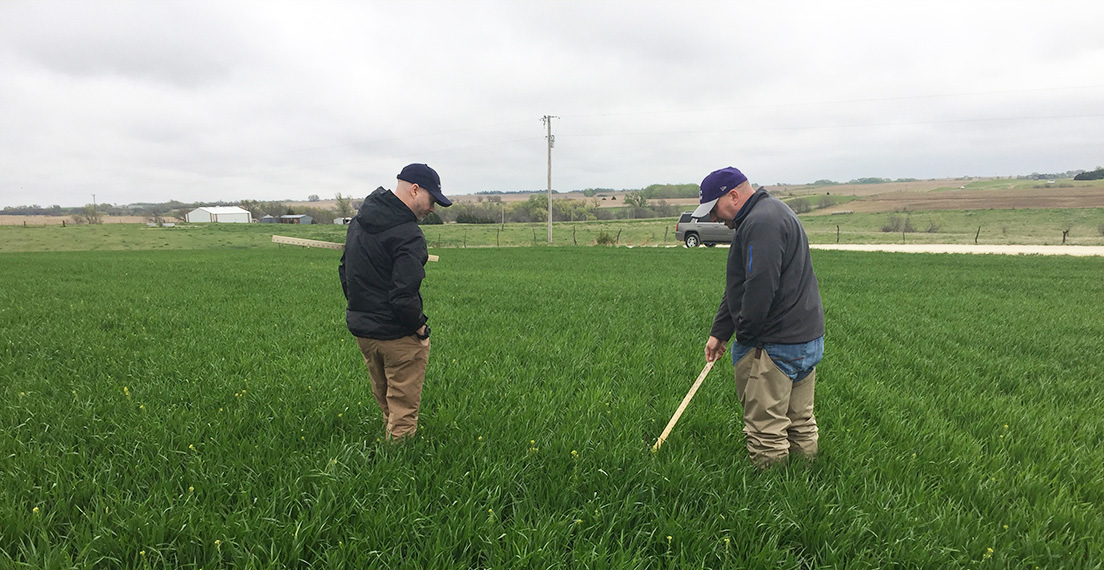By Claire Hutchins, USW Market Analyst
This week, two U.S. Wheat Associates (USW) colleagues and I joined the Wheat Quality Council (WQC) on its 62nd annual “Hard Winter Wheat” Tour for an early survey of the 2019/20 hard red winter (HRW) crop in Kansas and parts of surrounding states. Just a few hours before USW published this issue of “Wheat Letter,” the tour estimated a final average yield potential of 47.2 bushels per acre (bu/ac) or about 3.18 metric tons (MT) per hectare for the 2019/20 Kansas HRW crop. This year, tour participants made 469 stops to scout fields. Combining seeded area with per-acre yield potential, the total production potential estimate for Kansas was 307 million bushels or about 8.36 million metric tons (MMT). Last year’s total production estimate was 243 million bushels (6.61 MMT).

Each year, industry participants from across the United States and several countries gather in Manhattan, Kan., and spend the next two and a half days in small scout teams, randomly stopping at 9 to 17 fields in a full day. Each team follows a colored route established decades ago by WQC to ensure most of Kansas and parts of southern Nebraska and Northern Oklahoma are scouted by tour participants. Teams measure yield potential, determine an average for the route and estimate a cumulative, daily tour average when all scouts come together again in the evening.
Muddy Boots. Another purpose of the tour is to help educate a broad range of stakeholders about wheat production challenges. Scouts are asked to look for disease, week and insect pressure, as well as soil conditions. Last year, tour participants enjoyed dryer, warmer weather. This year, rain and colder temperatures gave first-time scouts, like me, a true look at variable spring weather in Kansas. Our muddy boots proved that last year’s severe drought, which covered most of the state as of late April, is a distant memory. The April 23, 2019, Drought Monitor shows zero drought or abnormal dryness across the state of Kansas.

On the first day, the tour traveled from Manhattan along several routes covering most northern Kansas counties. The cumulative Day 1 average yield potential was 46.9 bu/ac, the equivalent of 3.15 MT per hectare, compared to 38.2 bu/ac (2.57 MT/hectare) in 2018. To reach that average, participants surveyed 240 fields recording a range from a low of 16 bu/ ac to a high of 96 bu/ac. We saw very short and sparse wheat that was two to four weeks behind developmentally. Fields were adequately moist to slightly dry with no standing water. Temperatures were in the mid-40s Fahrenheit (a little more than 4 degrees Celsius) which prevents disease establishment and helps yield potential. Below-average temperatures in the next few weeks could help yield potential for winter wheat, a cool-season grass.
Participants also received a report on the Nebraska and Colorado wheat crops. Nebraska estimated an average 44.0 bu/ac (2.95MT/hectare), up slightly from last year’s tour estimate. Nebraska’s 2019 production forecast is currently 47.4 million bushels (1.29 MMT), up 8% from the 2018 estimate. Colorado predicted an average of 46.5 bu/ac (3.12 MT/hectare) with total production predicted to reach 97.2 million bushels (2.64 MMT), up 39% year-over-year, if realized.
Late Planting Impact. On the second day, the tour scouts traveled on routes from Colby in northwest Kansas to south-central Wichita, making 200 stops. The number of observations was down significantly from last year due to cold, rainy weather. Scouts reported most wheat was two to four weeks behind normal development due to late planting in the fall but continued to see nearly no disease pressure due to April and early May’s cooler than average temperatures. That could push the region’s peak harvest well into June, especially if the cool temperatures persist. This year, the tour estimated Day 2 average yield at 47.6 bu/ac (3.20 MT/hectare), for a combined two-day average yield of 47.2 bu/ac (3.17 MT/hectare) across 440 stops. Last year, the combined two-day average was 36.8 bu/ac (2.47 MT/hectare) on 601 stops.

Participants also received a crop report from Oklahoma, where adequate rainfall through the growing season helped increase the 2019 average yield projection compared projections in last year’s drought. The estimated average yield in Oklahoma is 37.4 bu/ac (2.51 MT/hectare), for a total production estimate of 119 million bushels (3.24 MMT). If realized, this would be up 50% over last year’s estimate on cool, moist weather and minimal disease pressure. However, marketing conditions are difficult for farmers. Low cash prices for winter wheat are causing many Oklahoma farmers to turn their fields to pasture or replace acres planted to HRW with cotton. Abandoned HRW acres are expected to reach 8% to 10% in 2019.

The final day of the tour was shorter, with each car making 3 to 4 field stops from Wichita to Manhattan where all the data were compiled in the final report. The Day 3 estimated average yield was 46.2 bu/ac (3.11 MT/ hectare), across 29 stops.
USW Director of Programs Erica Oakley and Assistant Director of Policy Elizabeth Westendorf and I will use what we learned on the tour to help educate overseas customers about the new crop and how development delays may affect their purchase decisions. I was raised on an irrigated farm in western Colorado, so this experience helps me understand the volatility of growing conditions with dryland wheat. I want to learn more to work with traders, and I look forward to participating in WQC’s Spring Wheat Tour in July. For more information, visit the Council’s website at https://www.wheatqualitycouncil.org.
Highlights and photos from the tour are posted on Facebook and Twitter using #wheattour19.


